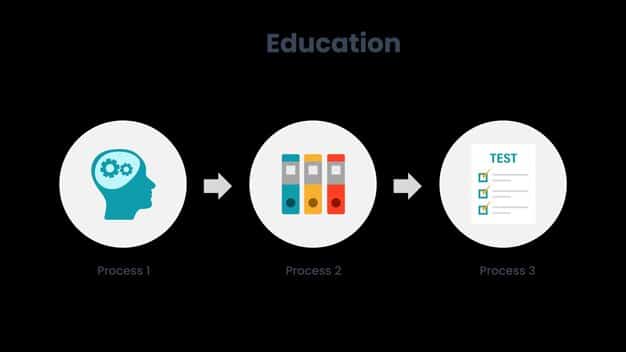Gen Z & Learning: Cognitive Psychology for Better Retention

Applying cognitive psychology principles is key to enhancing learning and retention for Gen Z, leveraging their digital fluency and unique learning styles to foster deeper engagement and more effective knowledge acquisition in educational and professional settings.
In a world shaped by digital natives, understanding how Gen Z and the science of learning: applying cognitive psychology principles for better retention is not just advantageous, it’s essential. This generation, born roughly between 1997 and 2012, processes information, interacts with content, and learns in ways distinctly different from previous cohorts. As educators, employers, and content creators, adapting our approaches to align with their cognitive blueprints is paramount for fostering deeper understanding and lasting knowledge.
understanding Gen Z’s unique learning landscape
Generation Z has grown up immersed in an omnipresent digital environment. This constant digital connectivity has profoundly influenced their cognitive development, attention spans, and preferred modes of information consumption. They are often characterized by their multitasking abilities, their preference for visual and interactive content, and their demand for instant access to information. These traits are not merely preferences but reflect fundamental shifts in how their brains engage with learning material.
Their online experiences have cultivated a rapid-fire information processing style. Unlike previous generations that might sit through long lectures or dense textbooks, Gen Z often seeks out bite-sized content, tutorials, and interactive simulations. This isn’t necessarily a deficit in attention but rather an adaptation to an information-rich environment where relevance and immediate utility are highly valued. Understanding this paradigm is the first step towards crafting effective learning strategies.
digital nativism and cognitive processing
The concept of “digital nativism” describes individuals who have grown up with technology as an integral part of their lives. For Gen Z, this means their brains have been continuously exposed to multi-modal stimuli, leading to neural pathways that are highly efficient in processing diverse information streams simultaneously. This constant stimulation impacts their attention allocation, often leading to a preference for dynamic, varied content over static, linear presentations.
- Prefer visual over textual information.
- Excel at multitasking with digital tools.
- Seek immediate feedback and interactive engagement.
- Value authenticity and peer-driven content.
However, this digital fluency also presents challenges. While they may be adept at toggling between multiple tasks, deep, sustained focus on a single, complex topic can sometimes be a hurdle. This necessitates learning designs that strategically break down information, provide opportunities for active processing, and incorporate elements that cater to their digital sensibilities without sacrificing depth of understanding.
Their reliance on search engines and instant information retrieval means they often prioritize finding answers quickly rather than engaging in the process of discovery or critical analysis. Educators must guide them in developing these higher-order thinking skills, integrating them into digital contexts that resonate with their learning styles.
In essence, tailoring educational approaches to Gen Z requires a nuanced understanding of their digitally-shaped cognitive strengths and areas that require cultivation. It’s about meeting them where they are and guiding them towards deeper, more meaningful learning experiences through scientifically-backed methods.
cognitive load theory: optimizing information delivery
Cognitive Load Theory is a cornerstone of educational psychology, providing a framework for designing instructional materials that optimize learning by managing the mental effort required to process new information. For Gen Z, who are accustomed to processing information quickly but can be overwhelmed by poorly structured content, this theory is particularly relevant. It posits that working memory has a limited capacity, and exceeding this capacity impedes learning.
The theory identifies three types of cognitive load: intrinsic, extraneous, and germane. Intrinsic load relates to the inherent complexity of the material itself. Extraneous load is generated by poor instructional design, such as cluttered slides or confusing language. Germane load is the mental effort directly contributing to learning and schema construction.
minimizing extraneous load for better retention
To engage Gen Z effectively, minimizing extraneous cognitive load is crucial. This means streamlining presentations, using clear and concise language, and avoiding unnecessary distractions. Given their exposure to highly curated digital content, Gen Z can be particularly sensitive to “noise” in learning materials. Simple, well-organized layouts are often more effective than overly complex ones.
- Design clean, uncluttered interfaces for digital learning.
- Use clear, straightforward explanations, avoiding jargon where possible.
- Integrate multimedia thoughtfully, ensuring it supports rather than distracts from the core message.
- Break down complex tasks into smaller, manageable steps.
For example, instead of presenting a dense paragraph of text, consider using bullet points, infographics, or short video clips to convey information. This not only aligns with their preference for visual content but also reduces the effort required to extract key information, freeing up cognitive resources for deeper understanding.

Another aspect is the judicious use of multimedia. While Gen Z appreciates visual content, simply adding videos or images indiscriminately can increase extraneous load if they are not directly relevant or are poorly integrated. The goal is to create coherent learning experiences where all elements work in harmony to convey information without overtaxing working memory.
fostering germane load: the path to deep learning
While minimizing extraneous load is about efficiency, fostering germane load is about effectiveness. Germane load is built by instructional strategies that encourage learners to connect new information with existing knowledge, form mental models, and critically evaluate concepts. For Gen Z, this often means moving beyond passive consumption to active engagement.
Strategies that promote germane load include problem-solving activities, reflection exercises, and opportunities for collaborative learning. When Gen Z learners are challenged to apply what they’ve learned, articulate their understanding, or teach peers, they are actively constructing knowledge, which leads to superior retention. This contrasts sharply with rote memorization, which is often short-lived.
By consciously managing intrinsic, extraneous, and germane cognitive loads, educators can design learning environments that are not only appealing to Gen Z but also inherently more effective in promoting deep learning and long-term retention. It’s about optimizing the journey of knowledge acquisition, not just the destination.
spaced repetition and retrieval practice: boosting memory retention
Two of the most powerful cognitive psychology principles for memory enhancement are spaced repetition and retrieval practice. These techniques are surprisingly simple yet profoundly effective, especially for Gen Z learners who benefit from structured reinforcement and active engagement. Integrating these methods can significantly improve how well new information is retained over time.
Spaced repetition involves reviewing information at increasing intervals over time. Instead of cramming all study into one session, learners revisit material periodically. This leverages the “spacing effect,” a well-documented phenomenon where memory is enhanced when learning is distributed over time rather than massed together.
implementing spaced repetition effectively
For Gen Z, who are familiar with algorithms and personalized experiences, spaced repetition can be introduced through adaptive learning platforms or simple self-testing schedules. The key is to optimize the intervals: review new material relatively soon after initial learning, then progressively extend the time between reviews as the information becomes more solidified in memory. This prevents forgetting and strengthens neural connections.
- Utilize flashcard apps that incorporate spaced repetition algorithms.
- Schedule regular, short review sessions rather than infrequent, long ones.
- Vary the context of review to promote flexible memory retrieval.
- Encourage learners to identify their “forgetting curve” and tailor their schedule.
Platforms like Anki or Quizlet automatically manage the spacing, making it effortless for students to apply this principle. This technology-driven approach resonates well with Gen Z’s digital fluency, turning what might otherwise be a tedious task into an efficient and often gamified process. The immediate feedback loop provided by these tools also aligns with their preference for real-time validation.
The beauty of spaced repetition lies in its efficiency. Instead of repeatedly going over already mastered material, it focuses attention on items that are on the verge of being forgotten, making study time more productive. This aligns with Gen Z’s desire for efficiency and goal-oriented learning.
the power of retrieval practice
Retrieval practice, also known as the “testing effect,” is the act of actively recalling information from memory rather than passively re-reading it. Each act of successful retrieval strengthens the memory trace, making it easier to recall that information in the future. It’s like exercising a muscle: the more you use it, the stronger it becomes.
For Gen Z, retrieval practice can take many forms beyond traditional tests. It can involve self-quizzing, explaining a concept to a peer, creating mind maps from memory, or even attempting to solve problems without referring to notes initially. The effort involved in retrieving the information is what makes the learning stick.
When learners actively try to recall information, they are not only assessing their knowledge but also strengthening the memory itself. Even unsuccessful attempts at retrieval can be beneficial, as they highlight gaps in understanding and prepare the brain for more effective encoding when the information is subsequently reviewed. This makes retrieval practice a powerful diagnostic tool as well.
By blending spaced repetition with frequent retrieval practice, learning experiences for Gen Z can become significantly more effective. These aren’t just study tips; they are scientifically validated strategies that tap into fundamental mechanisms of human memory to ensure knowledge is not just acquired but retained and readily accessible.
metacognition: teaching Gen Z how to learn
Metacognition, often described as “thinking about thinking,” is a critical skill for effective learning. It involves an awareness of one’s own thought processes, an understanding of how one learns best, and the ability to monitor and regulate one’s learning. For Gen Z, who often navigate vast amounts of information, developing strong metacognitive skills is crucial for distinguishing between superficial consumption and deep learning.
While Gen Z may be adept at finding information, they don’t always possess the inherent ability to critically evaluate its veracity, organize it effectively, or strategically plan their learning process. This is where metacognition comes into play, empowering them to become active agents in their own education, rather than passive recipients of content.
fostering self-awareness in learning
Encouraging self-awareness in Gen Z learners involves prompting them to reflect on their learning journey. This can include asking questions like: “What do I already know about this topic?” “What are my goals for this learning session?” “Which strategies am I using, and are they effective?” “How can I check my understanding?”
- Implement reflective journaling or post-learning self-assessments.
- Encourage setting clear, achievable learning goals before starting a task.
- Teach them to recognize and address their own misconceptions.
- Promote peer teaching and discussion as a means of self-monitoring understanding.
Digital tools can facilitate this by integrating self-assessment quizzes, progress trackers, and prompts for reflection within online learning modules. For example, a platform could ask students to predict their performance on a quiz before taking it, then reflect on why they succeeded or struggled afterward. This provides immediate feedback on their metacognitive accuracy.
By explicitly teaching metacognitive strategies, educators can equip Gen Z with the tools to become more independent and effective learners. This is not about spoon-feeding information but about teaching them how to *learn* independently in a continuously evolving information landscape.
planning, monitoring, and evaluating learning
Metacognition also encompasses the ability to plan one’s approach to a learning task, monitor one’s progress during the task, and evaluate the outcomes. For Gen Z, who might be prone to jumping into tasks without a clear strategy, explicit instruction in these areas is invaluable. They need to understand that learning is a process that can be managed and optimized.

| Key Principle | Brief Description |
|---|---|
| 🧠 Cognitive Load Theory | Optimizes information delivery by minimizing distractions and focusing on essential content to prevent working memory overload. |
| 🔄 Spaced Repetition | Reviewing material at increasing intervals over time to strengthen memory traces and enhance long-term retention. |
| 🎯 Retrieval Practice | Actively recalling information from memory, which significantly boosts retention and identifies knowledge gaps. |
| 💡 Metacognition | “Thinking about thinking”; understanding one’s own learning process to plan, monitor, and evaluate learning strategies effectively. |
frequently Asked Questions about Gen Z learning
Gen Z’s constant digital exposure fosters a preference for visual, bite-sized, and interactive content. They excel at processing multiple information streams but may struggle with sustained, linear focus. This necessitates dynamic learning designs that blend multimedia, interactivity, and structured guidance to encourage deep learning.
Cognitive load theory explains how working memory’s limited capacity affects learning. For Gen Z, who can be easily overwhelmed by extraneous information, it’s crucial for designing clear, concise materials. Minimizing unnecessary mental effort allows them to focus on understanding new concepts effectively, ensuring better retention.
Spaced repetition involves reviewing material at increasing intervals, while retrieval practice is actively recalling information. For Gen Z, these can be integrated using adaptive flashcard apps, self-quizzing, or peer teaching. These methods leverage their digital fluency to make studying more efficient and significantly boost long-term memory.
Metacognition, or “thinking about thinking,” helps Gen Z understand how they learn best and regulate their learning process. In an information-rich world, it empowers them to critically evaluate content, plan effectively, and monitor their progress. This fosters independent, self-directed learners who can adapt to new information challenges.
Gen Z is highly driven by purpose and real-world relevance. Connecting learning to current events, personal interests, or future career paths significantly boosts their intrinsic motivation. When they see the value in what they’re learning, engagement deepens, and information is more likely to be retained and applied effectively.
conclusion
Understanding and applying cognitive psychology principles is not just a theoretical exercise; it’s a practical imperative for optimizing learning and retention for Generation Z. Their unique digital upbringing has shaped their cognitive processes, attention spans, and preferences in profound ways. By consciously designing learning experiences that minimize cognitive load, leverage spaced repetition and retrieval practice, foster metacognitive skills, embrace active and experiential learning, and root content in relevance, we can unlock their full potential. This comprehensive approach moves beyond superficial engagement, encouraging deep understanding and equipping Gen Z with the tools to become adaptable and effective lifelong learners in an ever-evolving world. It’s about meeting them where they are and guiding them to where they need to be, scientifically.





